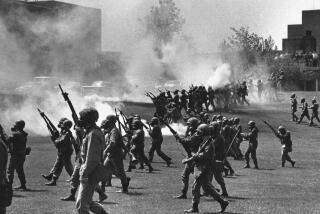PERSPECTIVE ON GUN CONTROL : A Massacre We Didn’t Hear About : Firearms in the hands of private citizens should play an important role in protection of the public safety.
- Share via
This is the story you saw on the evening news:
At lunch hour on Wednesday, Oct. 16, George Jo Hennard of Belton, Tex., smashed his Ford pickup through the plate glass doors of Luby’s cafeteria in Killeen, injuring some patrons immediately. While other patrons rushed toward the truck, believing the driver was a heart-attack victim, Hennard calmly climbed out of his pickup, took out two 9-millimeter semi-automatic pistols and started shooting people in the cafeteria’s serving line.
Hennard continued shooting for 10 minutes, reloading five times. One of his pistols jammed repeatedly, causing him to discard it. There would have been plenty of opportunity for any of the cafeteria’s customers or employees to return fire. None did because none of them were armed. Texas law forbids private citizens from carrying firearms out of their home or business. Luby’s employee manual forbids employees to carry firearms.
Police officers were inside Luby’s within minutes. But before they were able to corner Hennard in the cafeteria’s restroom, where he turned his gun fatally on himself, Hennard had killed 15 women and 8 men, wounded 19 and caused at least five more to be injured attempting to flee.
The Killeen massacre was ready-made excitement for the media: a madman with a gun, lots of gruesome pictures. CBS News devoted an entire “48 Hours” Dan Rather report to it. Sarah Brady of Handgun Control Inc. capitalized on it in a nationally published column to call Congress cowardly for voting down more stringent gun laws the next day.
Now here’s a story you probably didn’t see:
Late at night on Tuesday, Dec. 17, two men armed with recently stolen pistols herded 20 customers and employees of a Shoney’s restaurant in Anniston, Ala., into the walk-in refrigerator and locked it. Continuing to hold the manager at gunpoint, the men began robbing the restaurant.
Then one of the robbers found a customer who had hidden under a table and pulled a gun on him. The customer, Thomas Glenn Terry, legally armed with a .45 semi-automatic pistol, then fired five shots into that robber’s chest and abdomen, killing him instantly.
The other robber, who was holding the manager at gunpoint, opened fire on Terry and grazed him. Terry returned fire, hitting the second robber several times and wounding him critically.
The robbery attempt was over. The Shoney’s customers and employees were freed. No one else was hurt.
Because Terry was armed, and used his gun to stop two armed robbers who had taken a restaurant full of people hostage, there was no drawn-out crisis, no massacre, no victims’ families for Dan Rather to interview. Consequently, the story hasn’t received much coverage.
Among those who rely on national news media for their view of the country, the bloody image of Luby’s cafeteria is available to lend the unchallenged impression that guns in private hands serve only to kill innocent people. The picture of 20 hostages walking out of Shoney’s refrigerator unharmed, because a private citizen was armed that night, is not.
As we celebrate the bicentennial of the Bill of Rights, it’s worth noting that the Framers wrote the Second Amendment so the people’s defense would be in our own hands, and we wouldn’t have to rely on a “standing army” or “select militia” for our security. Though no police departments existed in America then, there’s no historical doubt that the Framers had considered centralized public defense, and considered it not merely ineffective, but itself dangerous to public safety. Recent vigilante-type police attacks, such as the Rodney King beating, lend credence.
Yet, it’s fashionable to relegate constitutional protections to the dustbin of history. Judges sworn to defend the Constitution ignore its clear provisions, as do legislators. Virtually every major organ of society--both political parties, the media, the American Bar Assn., the ACLU--urges them to do so.
Today’s “consensus reality” asserts that private firearms play no effective role in the civic defense, and that firearms must be restricted to reduce crime. The media repeat these assertions as a catechism, and treat those who challenge them as heretics.
Yet, we have before us an experiment showing us alternative outcomes. In one case, we have a restaurant full of unarmed people who rely on the police to save them. The result is 23 innocent lives lost, and an equivalent number wounded. In the second case, we have one armed citizen on the scene and not one innocent life lost.
How can the choice our society needs to make be any clearer?
It’s time to rid ourselves of the misbegotten idea that public safety can be achieved by unilateral disarmament of the honest citizen, and realize that the price of public safety is, like liberty, eternal vigilance. We can tire ourselves in futile debates on how to keep guns out of the wrong hands. Or we can decide that innocent lives deserve better than to be cut short, if only we, as a society, will take upon ourselves the civic responsibility of defending our fellow citizens, as Thomas Glenn Terry did in Alabama.
More to Read
Sign up for Essential California
The most important California stories and recommendations in your inbox every morning.
You may occasionally receive promotional content from the Los Angeles Times.













